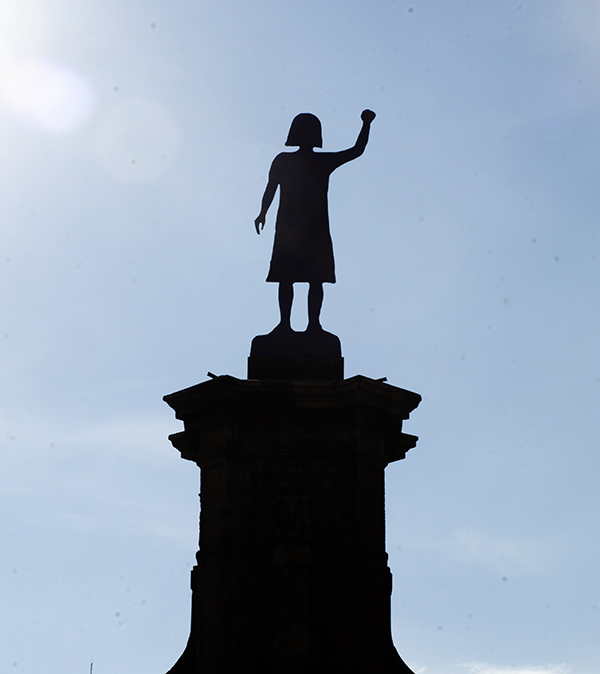
I was elated and surprised.
I couldn’t believe that the Mexican federal government and the City of Mexico had allowed, even embraced, a symbol of the women who fight against the femicide epidemic in Mexico on the grand Reforma Boulevard, the one with the famous Angel of Independence that bedazzles tourists and nationalists alike in the middle of the traffic-clogged roundabout at Reforma and Monterrey. Even better, this celebration of the women who fight stands on the pedestal where Christopher Columbus had stood since 1877 on a similarly prominent Reforma roundabout. Erected on September 25th 2021 by the feminist activist group Viva Nos Queremos, Antimonument (We Want Us Alive, Anti-Monument) in partnership with National Connection Network (mothers of victims of femicide, water defenders, survivors of acid attacks, Triqui, Otomí and Nahua women, and the mothers of the disappeared students from Ayotzinapa)[1], La Glorieta De Las Mujeres Que Luchan (Roundabout of the Women Who Fight) is now threatened to be removed. Too good to be truly true.

As many know,
Christopher Columbus was an Italian explorer who navigated four voyages across the Atlantic and was sponsored by the Catholic monarchs of Spain. His landing on the shores of Cuba and then the Gulf Coast of Mexico started the European colonization of the Americas and the subsequent oppression and exploitation of the Indigenous peoples who have lived here for Millenia. The Europeans claimed to have ‘discovered’ what they called the New World, implying of course that there was no one here—or of human status anyway— and that the resource-rich land was wide open and for the taking and, therefore, it was perfectly fine to ‘take the Indian out of the child’ as was said by Canada’s first Prime Minister John A. McDonald in his statement of the intention of Canada’s residential schools[2] or, as in the case of Cuba, all out extermination and, as in Mexico, enchant with the awe-inspiring aesthetic of Cathedrals through the story of Juan Diego, an Indigenous man who beheld the miracle of Guadalupe, the dark skinned Virgin Mary. But that’s another, albeit related, story.[3]
Back to Reforma 2022:
Like all nation states that wouldn’t exist without the stealing of the land and the brutalization of Indigenous peoples, regardless of the removal of all of the Christopher Columbuses, the colonial origin is still very much alive in its haunting. However, we are in an era of awakening to the atrocities that underlay Western Civilization as statues have been falling in countries where colonialism originated and those where the greed-glutting operations were carried out: numerous renditions of Canada’s Prime Minister John A. Macdonald have been toppled or removed and blood-red paint has been splattered on Queen Victoria; British activists rolled slave trader Edward Colston into Bristol Harbor; multiple Columbuses have come down in the US along with a lot of lynching forefathers (to name a few).[4] However, is the bedrock of colonialism being upheaved as the symbols of the glorified perpetrators fall? It’s hard to say.
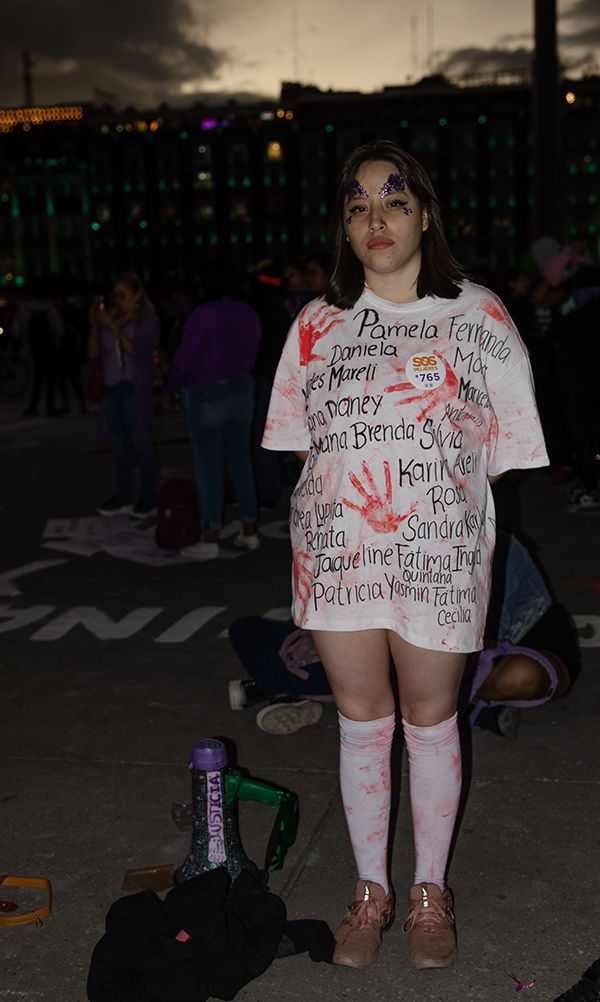
The Mexico City government had planned to replace Columbus with “The Young Woman of Amajaca,” a replica of an ancient statue of a young Indigenous woman. It cannot be denied that replacing the key colonizer with a replica of a Pre-Hispanic monument (and of a woman even) is an improvement.[5] Significantly, though, as in all colonial countries, Indigenous women are the most vulnerable to sexual assault and femicide. Is it not more critical at this time to honour the lives—disappeared, murdered, assaulted, resisting, fighting—now, the fate of this Pre-Hispanic representation of long before the needs of now?
The feminists and the families of missing children decided: No.
The government’s token gesture of honouring an idealized pre-colonial past is not enough. With their anti-monument towering triumphant, painted the colour of the glitter and smoke Mexican feminists use to demonstrate their resistance to male impunity and sexual violence, the names of disappeared and murdered women written on the walls, and a clothesline hung across the surrounding garden where women have written personal accounts of assaults, the activists have made this roundabout a site for protests and gatherings that have drawn attention to the epidemic of killings of women and girls in Mexico. “This place is from now on the roundabout of women who struggle and will be dedicated to those across the country who have faced violence, repression and re-victimization for fighting injustice,” Viva Nos Queremos, Antimonument wrote on their social networks.[6]
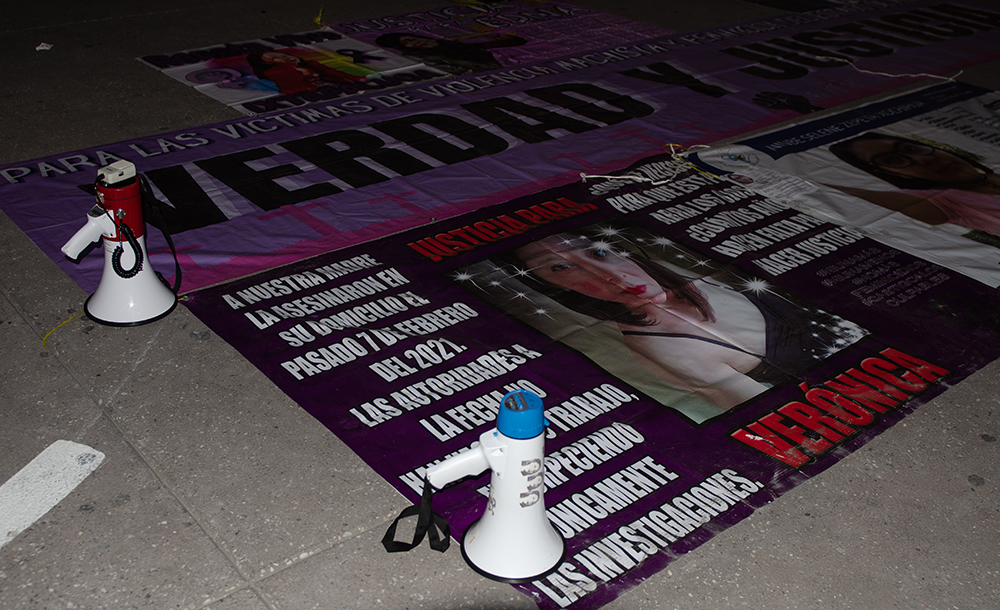
Rather than a token exoticization of Mexico’s pre-Hispanic, pre-Columbus past, the anti-monument represents the present of colonialism rather than exoticizing what was. A representation of the innocence of pre-exploitation is far from relevant in a country where an estimated 12-16 women are murdered per day by their husbands or boyfriends.[7] Instead of remembering who was oppressed, the anti-monument raises awareness for the present, the bravery of the women who resist and fight for present and future lives free from violence. As coalition member Érica explains: “It’s not about putting up a monument to worship the past, but one to recognize the present fight, all the women who have disappeared.”[8]
But are Mexicans happy about it?
Actually, it appears, this time, possibly so.[9] Unlike on November 25th, 2019 and March 8th, 2020 when militant feminists vandalized all of the colonial monuments along Reforma and popular opinion valued the monuments over acknowledging the femicide epidemic,[10] there has been public outcry that this act of activism should stay where it is: in the strategic location on Reforma, for Mexico, and the world, to see.
It would be a logical decision by the government to let the women who fight and the families who have lost their loved ones have this symbol of the struggle, a place to gather to remember and resist and the opportunity to raise far-reaching awareness from a prominent and symbolic location. Building “The Young Woman of Amajaca” would cost $12 million pesos and the feminists argue that “with those 12 million pesos they could do creative workshops in schools and public squares against violence, equipment for collective searchers, support for shelters, etc.”[11] When it comes to justice, such logic is often lacking.
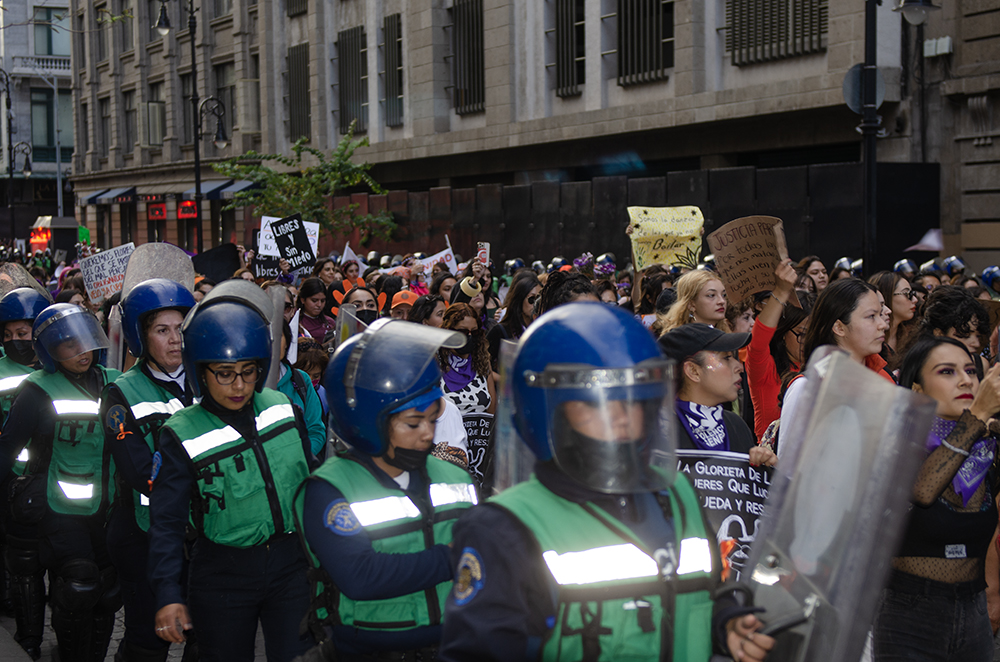
With not even access to rape kits
as part of the government agenda to trace perpetrators through their DNA and at least acknowledge the validity of sexual assault; an eery presence of police lining Reforma on par with the women who marched November 25th for the International Day for the Elimination of Violence Against Women; large scale photographs of missing and murdered young Mexican woman sprawled and plastered on all surfaces of the Zocalo; an UNAM conference earlier that day entitled “The Right to a Life Free of Violence: the Hard Road to Feminist Justice” where corpses were the main topic on the agenda, for we women, we humans who fight, it is far from finished.
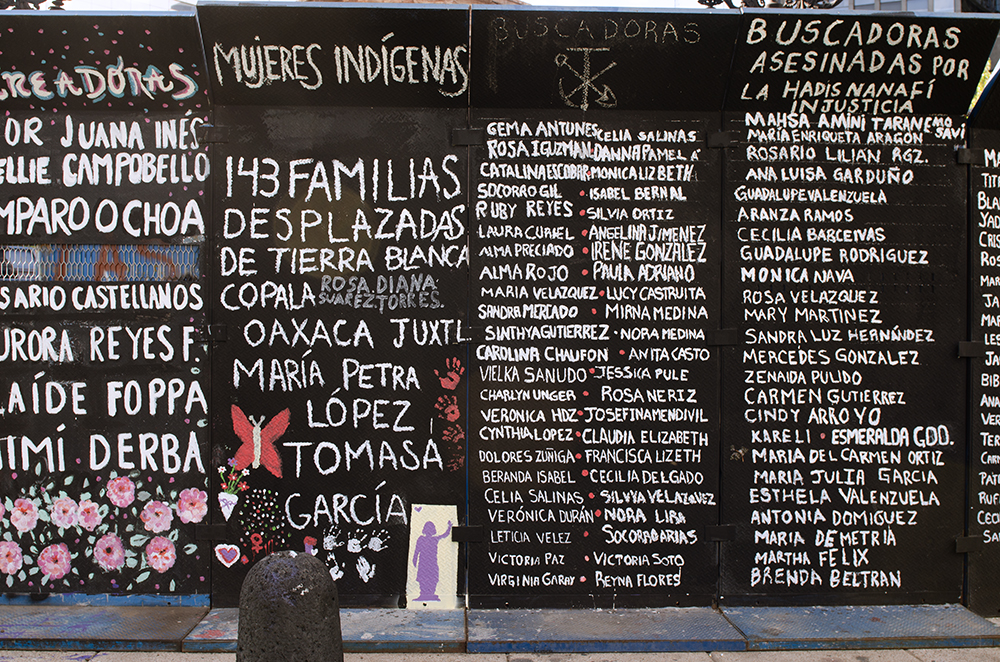
#iloveendnotes
[1] https://www.netflix.com/mx-en/title/81045551
[2] https://nationalpost.com/news/canada/here-is-what-sir-john-a-macdonald-did-to-indigenous-people
[3] https://www.mexperience.com/the-virgin-guadalupe-and-juan-diego/
[4] https://www.nytimes.com/2020/06/24/us/confederate-statues-photos.html
[5] The occupation took place in a context in which México City officials announced they would remove the statue of Columbus, a colonialist figure, and that it would be replaced by a statue by artist Pedro Reyes. His statue was called Tlali, and it was the subject of complaints due to the way he represented the body of an Indigenous woman. https://piedepagina.mx/mexico-city-activists-defend-monument-to-women-in-struggle/
[6] https://www.artnews.com/art-news/news/mexico-city-takes-down-feminist-anti-monument-1234637007/
[7] It can be argued that an epidemic of machismo due to the emasculated third-world male in patriarchy is mainly responsible for the femicide rate in Mexico. See Sayak Valencia’s Gore Capitalism.
[8] https://piedepagina.mx/mexico-city-activists-defend-monument-to-women-in-struggle/
[9] https://www.animalpolitico.com/2022/10/glorieta-mujeres-luchan-antimonumenta-cdmx/
[10] See my March 2021 article in Vigilance Magazine “The Life of a Woman is More Important than an Historical Monument.” https://www.vigilancemagazine.com/post/life-of-a-woman
[11] https://www.sopitas.com/noticias/plan-gobierno-cdmx-antimonumenta-reforma-esconder-circuito/?fbclid=IwAR3Xw5qvSI8asImA4s2uE32mojEA2KW-XK9D_-_WJqk3f_gxe7msBc6-TDI
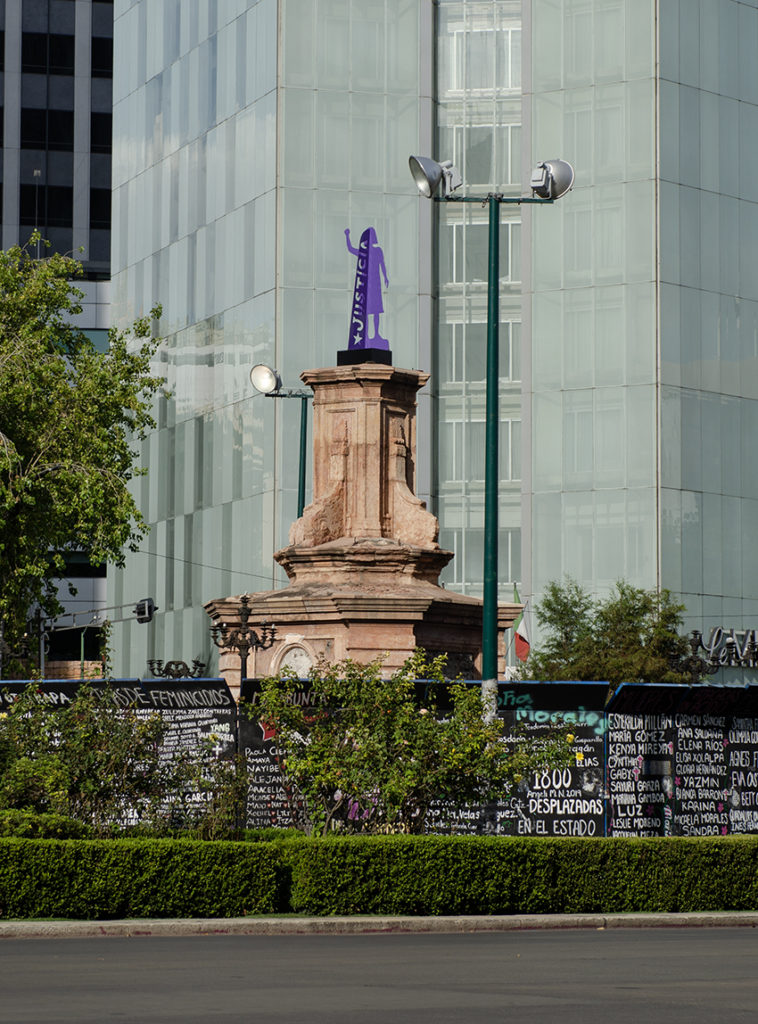
About the Blogger:
I am an art critic, visual and performance artist, author and feminist activist. My work focuses on systemic violence in patriarchy: be it gender, race, the environment or speciesism. My art criticism has been published internationally in magazines, anthologies and artist catalogues in English and Spanish and I have exhibited and performed across Canada, in the US and in Mexico. I am the recipient of the “Ellie Liston Hero of the Year Award” 2022 for being instrumental in the life sentence given to a serial rapist who abducted and brutalized me and countless other women. Since that time, as I write in my book, Victim: A Feminist Manifesto from a Fierce Survivor:
“And, believe it or not, what I suffered and survived …. all of those years ago gave me a gift of knowing my strength and what I can survive. And now, resistance, fighting for justice for all, is what I live for. My life is far bigger than myself.”(186)
My personal experience of surviving and triumphing over sexual violence and trauma is the origin of Logical Feminism.
I live in Mexico City and British Columbia, Canada. Victim: A Feminist Manifesto from a Fierce Survivor is my debut book.